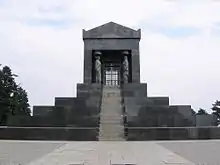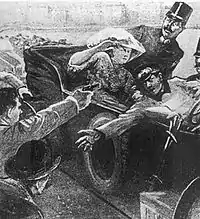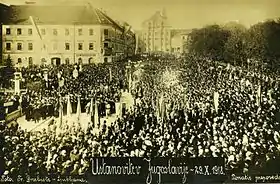Yugoslavism
Yugoslavism (Serbo-Croatian: јugoslavizam, југославизам; Slovene: јugoslavizem) or Yugoslavdom (Serbo-Croatian: јugoslovenstvo, југословенство; Slovene: јugoslovanstvo) refers to the unionism, nationalism, or patriotism associated with South Slavs/Yugoslavs and Yugoslavia. Yugoslavism has historically advocated the union of all South Slav populated territories now composing Bosnia and Herzegovina, Croatia, Montenegro, Serbia (and the disputed region of Kosovo), Slovenia, North Macedonia,[1] and, for some like Ivan Meštrović, Bulgaria.[2] It became a potent political force during World War I with the assassination of Archduke Franz Ferdinand of Austria by the Yugoslavist militant Gavrilo Princip and the subsequent invasion of Serbia by Austria-Hungary. During the war the Yugoslav Committee composed of South Slav emigres from Austria-Hungary (including twelve Serbs, three Croats, and one Slovene), supported Serbia and vouched for the creation of a Yugoslav state. On 1 December 1918, King Peter of Serbia proclaimed the Kingdom of Serbs, Croats, and Slovenes, commonly known as "Yugoslavia". During the Yugoslav period, a Yugoslav identity (the "Yugoslav nation", Jugoslovenska nacija) was propagated.
.svg.png.webp)
.svg.png.webp)

Background
Processes such as the Rise of nationalism in Europe, Rise of nationalism in the Ottoman Empire, Italian unification, and German unification were events in the 19th century and reflected among the South Slavs, too, as their shared mother tongues all belong to a family of closely related languages. This, along with their shared history, prompted some to demand a South Slav unification akin to that which occurred for the Italians and Germans; but here there were greater political obstacles as there was no sovereign South Slav state until the end of the Serbian Revolution (with the South Slav peoples being in the Ottoman and Habsburg realms), and it was only with the end of the First World War that the better developed Croatia and Slovenia broke from Habsburg and German rule.
There were also South Slavic ethnic nationalists who endorsed Yugoslavism as a means to achieve their ethnicity's unification. After 1878, Serbian nationalists merged their goals with those of Yugoslavists, emulating the leading role of the kingdom of Sardinia and Piedmont in the Risorgimento of Italy by claiming that Serbia sought not only to unite all Serbs in one state, but that it intended to be a South Slavic equivalent of Piedmont, uniting all South Slavs into one state to be known as Yugoslavia.[3] Croatian nationalists became interested in Yugoslavism as a means to achieve the unification of the Croatian lands, in opposition to their division under Austria-Hungary, particularly with Yugoslavist leader Strossmayer advocating this as being achievable within a federalized Yugoslav monarchy.This sentence contradicts the Strossmayer article. [4] Slovenian nationalists such as Anton Korošec also endorsed Yugoslav unification during the First World War, seeing it as a means to free Slovenia from Austro-Hungarian rule.[5]
Yugoslavism also had support among Bulgarians, most notably Aleksandar Stamboliyski.[6] However, Bulgarian nationalists resented Serbia's annexation of Vardar Macedonia in 1913, a region they had sought to incorporate into Bulgaria, and the Bulgarian government thus rejected a pan-South Slavic unification led by Serbia, and fought against Serbia on the side of the Central Powers who had promised Bulgaria Vardar Macedonia in exchange for their alliance.[4] The Bulgarian coup d'état of 1934 briefly brought pro-Yugoslav Bulgarians to power. They declared their intention of immediately forming an alliance with France and leading Bulgaria into an integral Yugoslavia, but this was not achieved.[7]
Some Yugoslavists claim that the factional divide, differences, and conflict between the Yugoslav peoples are the result of foreign imperialism in the history of the Balkans.[8] As a result of religious divisions, Yugoslavism has typically avoided religious overtones.[8]
Yugoslavism had two major internal divisions that typically splintered the movement. One faction promotes a centralised state and assimilation of all ethnicities into a single Yugoslav nationality.[8] The other faction supports a decentralised and multicultural federation that would preserve existing identities while promoting unity, while being opposed to the idea of centralisation and assimilation that they deemed as effectively favouring Serb hegemony rather than Yugoslav unity.[8]
Rise of Yugoslavism
The concept of Yugoslavism first arose in the 1830s with the creation of the Illyrian movement that based its views of South Slavic national identity upon the ideal of national awakening of the French Revolution.[1] The Illyrian movement was formed by Croatian writers who emphasized the common ethnic and linguistic ties between the South Slavic peoples as a basis for their cooperation and eventual political unification.[1] The Illyrian movement was centred in Croatia and Croatian politics, believing that a Croatian renaissance was necessary to be achieved prior to the movement's long-term goal of ethnic and political unification of South Slavs.[1] Ljudevit Gaj, a key figure of the Illyrian movement declared Croats and Serbs to be the two major subgroups of the South Slav or "Illyrian" nationality, which also included Slovenes, and South Slavic inhabitants of Bosnia and Herzegovina, Bulgaria, and Montenegro.[1] In spite of its pan-South Slavic ideals, the Illyrian movement was dominated by upper-class Croats, originally with little support amongst Serbs, Slovenes, or other South Slavic peoples.[1]
During the Revolutions of 1848, the Illyrian movement became a strong political force in the Habsburg Austrian Empire, and advocated cooperation between Croats and Serbs to oppose Hungarian rule of its South Slavic populated territories.[1]
The concept and term "Yugoslavism" was founded in the later half of the nineteenth century by two Croatian Catholic bishops: Josip Juraj Strossmayer, an ethnically mixed Croat-German liberal politician; and Franjo Rački. Both emphasized Yugoslavism as a supranational cultural patriotism to unite South Slavs on the basis of common origins, cultural ties, and spiritual bonds of South Slavs.[9] However like the Illyian movement, Strossmayer's and Rački's Yugoslavism found little support outside Croatia.[10] Yugoslavism faced strong competition from other nationalist movements seeking to rally the various South Slav peoples, such as Serbian nationalism.[10] Initially Serbian nationalists who were focused on fighting the Turks, did not cooperate with Yugoslavists, seeing little benefit in a joint movement or unification with Croats of the Austro-Hungarian Empire.[10] However this period of noncooperation was briefly broken in the mid-1860s when Strossmayer and Serbian foreign minister Ilija Garašanin agreed to work together to create "a Yugoslav state free from Austria or Turkey."[11]
Yugoslavism is related to two contrasting doctrines from the 19th century: Pan-Slavism which then focused on unification and independence of Slavic nations from non-Slavic rulers, and Austroslavism which appealed to Slavic subjects of the Habsburg Monarchy as it had been concocted to unify Slavic nations and serve their interests within the Austro-Hungarian Empire.[12]
The concept of Yugoslavism did not become strong until the beginning of the twentieth century due to the lack of belief that South Slavs could realistically unify and the lack of popular government in Yugoslav populated territories.[8] Yugoslavism began to arise with the overthrow of the Obrenović dynasty in Serbia in 1903 and the creation of a popular government within a constitutional monarchy.[8] After the annexation of Bosnia and Herzegovina by Austria-Hungary in 1908 Yugoslavism soared as the multiple South Slav denominations saw themselves as victims of foreign imperialism.[8]
Famous Croat sculptor Ivan Meštrović became a supporter of Yugoslavism and Yugoslav identity after he traveled to Serbia and became impressed with Serb culture.[13] Meštrović created a sculpture of Serbian folk-legend hero Prince Marko at the International Exhibition in Rome in 1911, when asked about the statue, Meštrović replied "This Marko is our Yugoslav people with its gigantic and noble heart".[13] Meštrović wrote poetry speaking of a "Yugoslav race".[13] Those who knew Meštrović's views referred to him as "The Prophet of Yugoslavism".[13]
In 1912, the eruption of the Balkan Wars saw various South Slavs unite against the Ottoman Empire.[8] In 1913, Slovene intellectuals published a manifesto recognising the existence of a Yugoslav nation and calling for its independence, declaring:
As it is a fact that we Slovenes, Croats and Serbs constitute a compact linguistic and ethnic group with similar economic conditions, and so indissolubly linked by a common fate on a common territory that no one of the three can aspire to a separate future, and in consideration of the fact that among the Slovenes, Croats, and Serbs, the Jugoslav thought is even today strongly developed, we have extended our national sentiments beyond our frontier to the Croats and Serbs…By this we all become members of one united Jugo-slav nation.[14]
World War I and the creation of Yugoslavia

.jpg.webp)
The assassination of Archduke Franz Ferdinand of Austria by Yugoslavist revolutionary Gavrilo Princip, a Serb associated with Young Bosnia, a group composed of mainly Serbs, but also Bosnian Muslims and Croats, marked the beginning of a militant nationalist activity by South Slavs against Austro-Hungarian rule.[14] At his trial in 1914, Princip stated: "I am a Yugoslav nationalist, aiming for the unification of all Yugoslavs, and I do not care what form of state, but it must be free from Austria."[15] The assassination of Franz Ferdinand however triggered resentment amongst those Austro-Hungarian Croats and Slovenes who had favoured being within Austria-Hungary.[8]
In response to the outbreak of the war a number of Croats and diaspora Serbs supported Croat-Serb cooperation against Austria-Hungary with the desire of creating a federation based on cooperation between them.[14] Serbs in Serbia on the other hand preferred either a Greater Serbia or a centralized Yugoslavia that would in effect create a Greater Serbia within it.[14] The leadership of the Croatian Peasant and social democratic parties in Croatia and Slovenia generally supported a federal Yugoslav state that would recognize the equality of the Serb, Croat and Slovene nations as distinct and separate tribal sub-nations of the Yugoslav nation.[14]
As the Serbian military made advances against Austria-Hungary in the early months of the war, Serbian Prime Minister Nikola Pašić requested support from the Serbian parliament to support the Serbian government's official war aims that declared that Serbia would support the liberation of the Serbs, Croats, and Slovenes under Austro-Hungarian rule.[8] Pašić supported the creation of the Yugoslav Committee to be composed of South Slav émigrés from Austria-Hungary.[8] The Yugoslav Committee was led by Yugoslavist Ante Trumbić and initially composed of twelve Croats (including eight from Dalmatia and two from Croatia proper), three Serbs, and one Slovene.[8] The Yugoslav Committee lobbied the Allies to support the liberation of the South Slav peoples of Austria-Hungary.[8] Pašić was dismayed with the discovery that the Allies had promised to give Italy a substantial portion of Dalmatia and believed that the Committee should attempt to convince the Allies that this was unacceptable and an injustice.[8]
In 1917, Pašić, representing the Serbian government, and Trumbić, representing the Yugoslav Committee (including twelve Croats, three Serbs, and one Slovene) signed the Corfu Declaration on the Greek island of Corfu that declared the intention to create a Yugoslav state to be known as the Kingdom of Serbs, Croats, and Slovenes that was to be headed by a "constitutional, democratic, and parliamentary monarchy" headed by the Serbian ruling dynasty, the House of Karađorđević.[8]

At the end of World War I, the National Council of Slovenes, Croats and Serbs was formed in Zagreb. Shortly thereafter, on 1 December 1918, Prince Regent Alexander of Serbia proclaimed the existence of the Kingdom of Serbs, Croats, and Slovenes which was recognized by Belgrade and the National Council in Zagreb on the 28th and 29 December.[8]
Kingdom of Yugoslavia
Vladimir Dvorniković, a famous philosopher, advocated the establishment of a Yugoslav ethnicity in his 1939 book entitled "The Characterology of the Yugoslavs". His views included eugenics and cultural blending to create one, strong Yugoslav nation.[16] He did not dismiss the differences among people that inhabited Yugoslavia, but stressed that these differences were "contingent and temporary and that they mask a deeper and more profound racial unity".[16] He also believed that "the primary ability of Yugoslavs is their ability to sacrifice themselves for a higher goal".[16] Dvorniković also advocated the idea of a Dinaric race, and his book overall gives a comprehensive description of unitarist Yugoslav mythology.[16] Several nationalist and far-right groups arose in support of Yugoslavism, such as the Yugoslav Radical Union, ORJUNA and Yugoslav National Movement.
SFR Yugoslavia
During the Titoist era, a Yugoslav socialist patriotism was advocated by the Yugoslav government.[17][18] It stressed that this socialist patriotism was not related to nationalism.[17] The League of Communists of Yugoslavia denounced nationalism, declaring that "every nationalism is dangerous".[19] Yugoslav leader Josip Broz Tito sought to form a communist community of "new people" of socialist Yugoslavia, based on the concept of Brotherhood and Unity - the "brotherhood" referring to the community of nations living in the socialist Yugoslavia while the "unity" referred to the unity of the working class.[20]
The basis of this socialist patriotism was the armed struggle by the Yugoslav Partisans against the Axis Powers who occupied and partitioned Yugoslavia during World War II.[21] The League of Communists claimed that the different nations of Yugoslavia had united in a common struggle against the Axis during the war and thus had legitimized the future unity of multi-ethnic Yugoslavia.[21] This was broadly correct for some parts of Yugoslavia, but during the war there had been significant cooperation with the Axis powers in Croatia, which the Axis had established as a puppet state allied to Italy and Germany.
Yugoslav nation
In the early days of Yugoslavia, influential intellectuals Jovan Cvijić and Vladimir Dvorniković advocated the Yugoslavs as a Yugoslav supra-ethnic nation that had tribal ethnicities, such as Croats, Serbs, and others within it.[16]
Identity politics failed to assimilate the South Slavic peoples of Yugoslavia into a Yugoslav identity.[22] During the reign of King Aleksandar I, a modern single Yugoslav identity was unsuccessfully propagated to erase the particularistic identities.[22]
See also
- Yugo-nostalgia
- Titoism
- Balkanization
- Yugoslavs
- Serbian–Montenegrin unionism
- Bosnianism
- Croatian nationalism
- Macedonian nationalism
- Montenegrin nationalism
- Serbian nationalism
- Slovenian nationalism
- Bulgarian nationalism
- Czechoslovakism
- Pan-Slavism
Compare with
Further reading
- Ivešić, T. (2020). "The Yugoslav National Idea Under Socialism: What Happens When a Soft Nation-Building Project Is Abandoned?" Nationalities Papers
References
Citations
- Cohen 1995, p. 4.
- Uspomene na političke ljude i događaje ([3. izd.] ed.). Nakladni zavod Matice hrvatske. ISBN 86-401-0248-1.
- Motyl 2001, pp. 470.
- Motyl 2001, p. 105.
- Motyl 2001, p. 276.
- Ahmet Ersoy, Maciej Górny, Vangelis Kechriotis. Modernism: The Creation of Nation-States. Central European University Press, 2010. p. 363.
- Khristo Angelov Khristov. Bulgaria, 1300 years. Sofia, Bulgaria: Sofia Press, 1980. p. 192.
- Dragnich 1983, pp. 3–11.
- Cohen 1995, pp. 4-5.
- Cohen 1995, p. 5.
- Cohen 1995, pp. 5-6.
- Magcosi, Robert; Pop, Ivan, eds. (2005), "Austro-Slavism", Encyclopedia of Rusyn History and Culture, Toronto: University of Toronto Press, p. 21
- Ivo Banac. The national question in Yugoslavia: origins, history, politics. Cornell University Press, 1984. Pp. 204-205.
- Djokić 2003, pp. 24–25.
- Malcolm, Noel (1996). Bosnia: A Short History. New York University Press. p. 153. ISBN 0-8147-5561-5.
- Wachte, Andrew (1998). Making a Nation, Breaking a Nation Making a Nation, Breaking a Nation Literature and Cultural Politics in Yugoslavia. Stanford University Press. pp. 92–94. ISBN 0-8047-3181-0.
- Sabrina P. Ramet. Social currents in Eastern Europe: the sources and consequences of the great transformation. Duke University Press, 1995. Pp. 207.
- Teresa Rakowska-Harmstone. Communism in Eastern Europe. Indiana University Press, 1984. Manchester, England, UK: Manchester University Press ND, 1984. p. 267.
- Ramet 2006, p. 603.
- Djokić 2003, p. 252.
- William Joseph Buckley. Kosovo: contending voices on Balkan interventions. William B. Eerdmans Pub., 2000. p. 144.
- Nielsen 2014.
Sources
- Works cited
- Cohen, Lenard J. (1995). Broken bonds: Yugoslavia's disintegration and Balkan politics in transition. Cambridge, England; Malden, Massachusetts: Westview Press. ISBN 0-8133-2477-7.
- Djokić, Dejan (2003). Yugoslavism: Histories of a Failed Idea, 1918-1992. C. Hurst & Co. Publishers. ISBN 978-1-85065-663-0.
- Dragnich, Alex N. (1983). The First Yugoslavia: Search for a Viable Political System. Hoover Press. ISBN 978-0-8179-7843-3.
- Jović, Dejan (2009). Yugoslavia: A State that Withered Away. Purdue University Press. ISBN 978-1-55753-495-8.
- Motyl, Alexander J. (2001). Encyclopedia of Nationalism, Volume II. Academic Press. ISBN 0-12-227230-7.
- Sekulic, D., Massey, G. and Hodson, R., 1994. Who were the Yugoslavs? Failed sources of a common identity in the former Yugoslavia. American Sociological Review, pp. 83–97.
- Nielsen, Christian Axboe (2014). Making Yugoslavs: Identity in King Aleksandar's Yugoslavia. University of Toronto Press. ISBN 978-1-4426-2750-5.
- Ramet, Sabrina P. (2006). The Three Yugoslavias: State-building and Legitimation, 1918-2005. Indiana University Press. ISBN 0-253-34656-8.
- Troch, Pieter (2015). Nationalism and Yugoslavia: Education, Yugoslavism and the Balkans before World War II. I.B. Tauris. ISBN 978-0-85773-768-7.
- Wachtel, Andrew (1998). Making a Nation, Breaking a Nation: Literature and Cultural Politics in Yugoslavia. Stanford University Press. ISBN 978-0-8047-3181-2.
External links
 Media related to Yugoslav patriotism at Wikimedia Commons
Media related to Yugoslav patriotism at Wikimedia Commons
